light TOYOTA tC 2015 (in English) Owner's Manual
[x] Cancel search | Manufacturer: TOYOTA, Model Year: 2015, Model line: tC, Model: TOYOTA tC 2015Pages: 492, PDF Size: 9.63 MB
Page 99 of 492
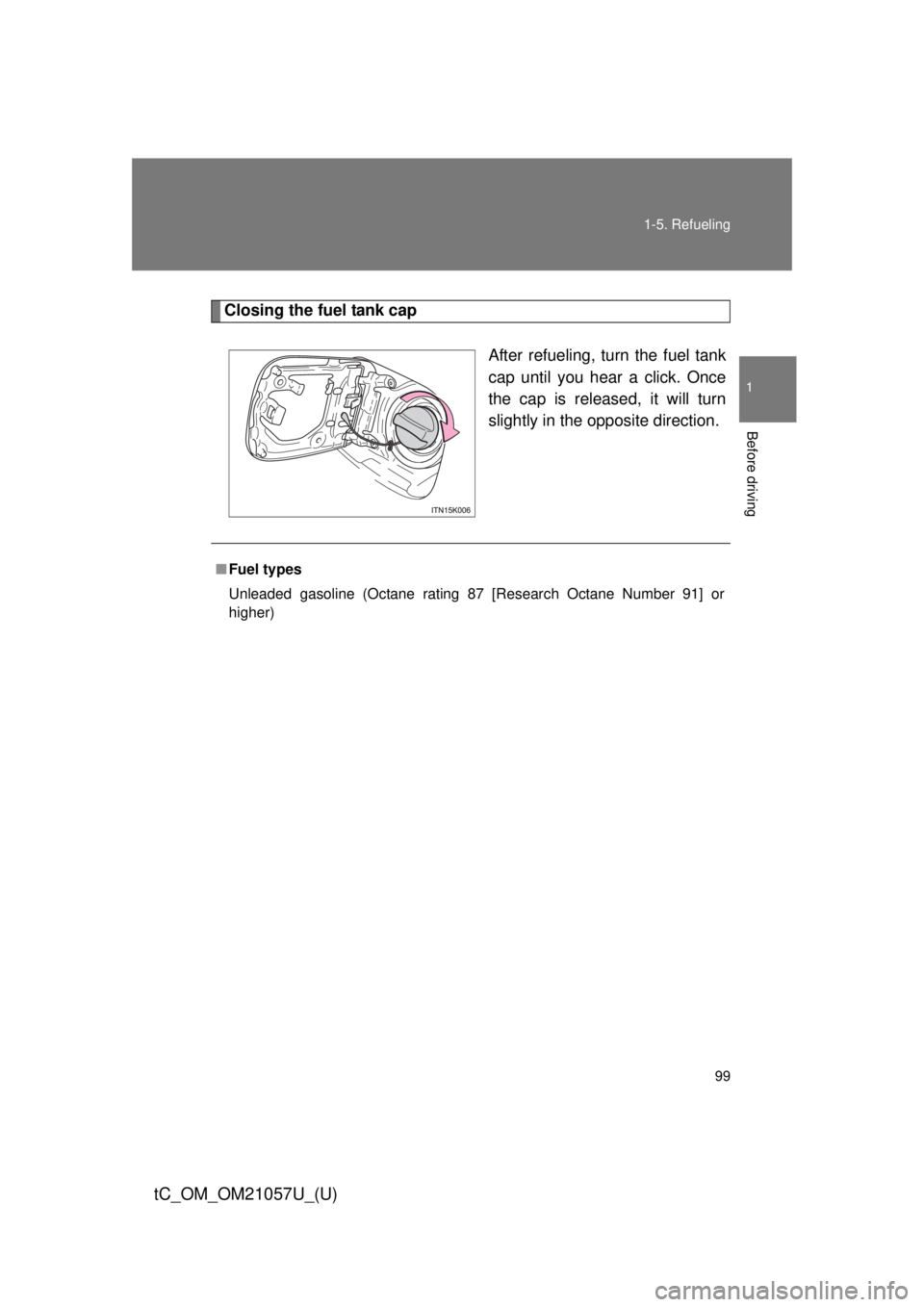
99
1-5. Refueling
1
Before driving
tC_OM_OM21057U_(U)
Closing the fuel tank cap
After refueling, turn the fuel tank
cap until you hear a click. Once
the cap is released, it will turn
slightly in the opposite direction.
■Fuel types
Unleaded gasoline (Octane rating 87 [Research Octane Number 91] or
higher)
Page 102 of 492
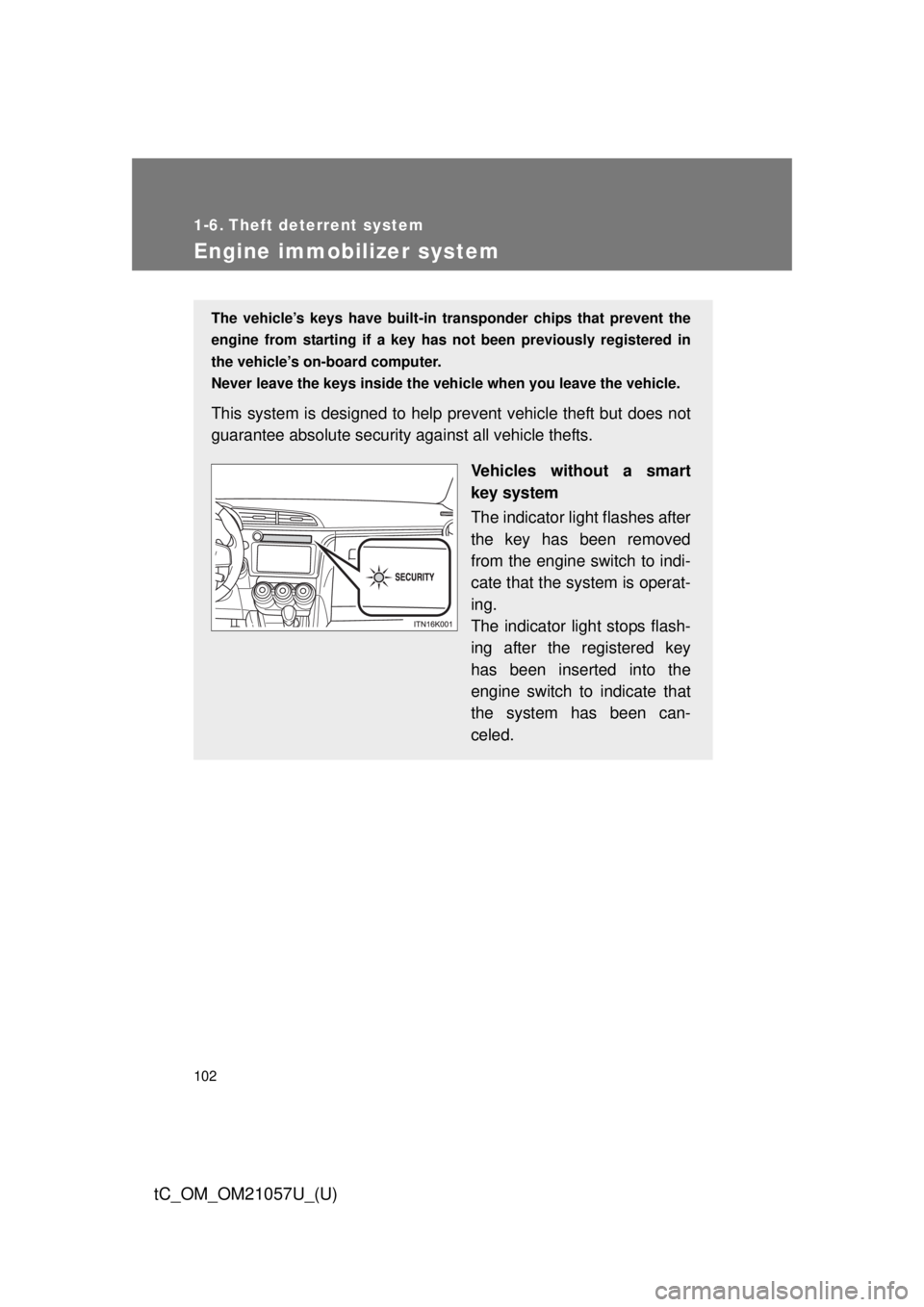
102
tC_OM_OM21057U_(U)
1-6. Theft deterrent system
Engine immobilizer system
The vehicle’s keys have built-in transponder chips that prevent the
engine from starting if a key has not been previously registered in
the vehicle’s on-board computer.
Never leave the keys inside the vehicle when you leave the vehicle.
This system is designed to help prevent vehicle theft but does not
guarantee absolute security against all vehicle thefts.
Vehicles without a smart
key system
The indicator light flashes after
the key has been removed
from the engine switch to indi-
cate that the system is operat-
ing.
The indicator light stops flash-
ing after the registered key
has been inserted into the
engine switch to indicate that
the system has been can-
celed.
Page 103 of 492
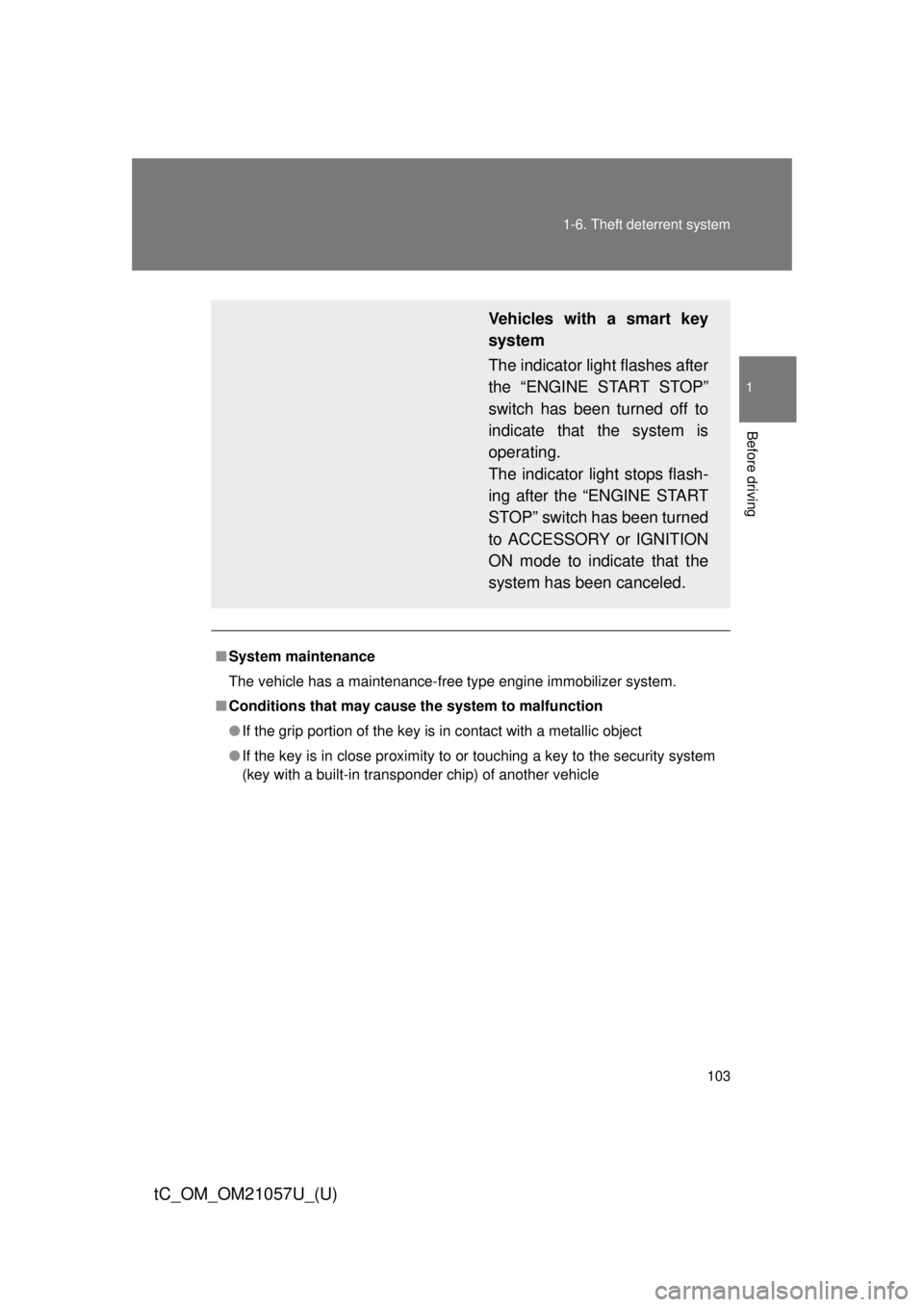
103
1-6. Theft deterrent system
1
Before driving
tC_OM_OM21057U_(U)
■
System maintenance
The vehicle has a maintenance-free type engine immobilizer system.
■ Conditions that may cause the system to malfunction
● If the grip portion of the key is in contact with a metallic object
● If the key is in close proximity to or touching a key to the security system
(key with a built-in transponder chip) of another vehicle
Vehicles with a smart key
system
The indicator light flashes after
the “ENGINE START STOP”
switch has been turned off to
indicate that the system is
operating.
The indicator light stops flash-
ing after the “ENGINE START
STOP” switch has been turned
to ACCESSORY or IGNITION
ON mode to indicate that the
system has been canceled.
Page 110 of 492
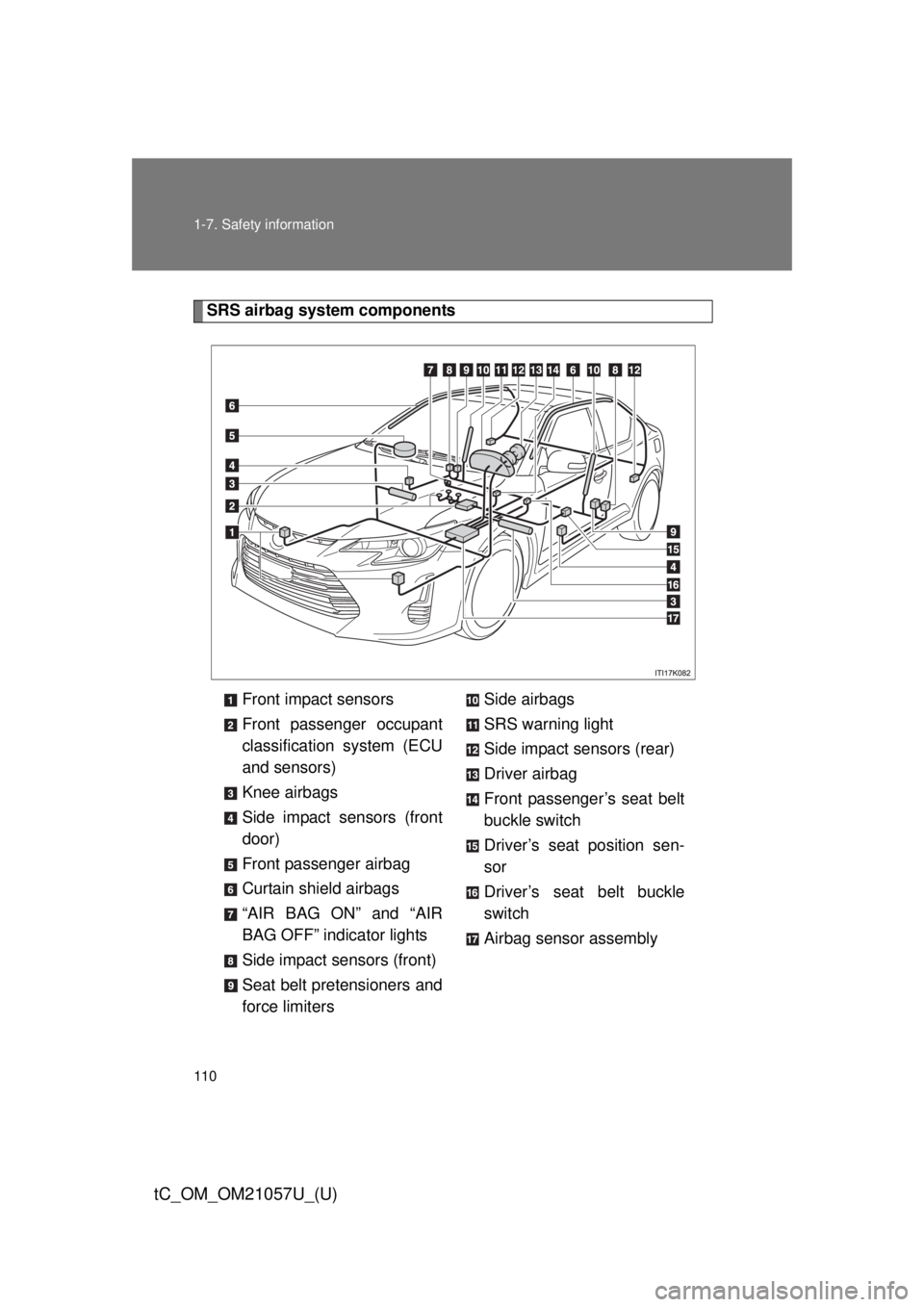
110 1-7. Safety information
tC_OM_OM21057U_(U)
SRS airbag system componentsFront impact sensors
Front passenger occupant
classification system (ECU
and sensors)
Knee airbags
Side impact sensors (front
door)
Front passenger airbag
Curtain shield airbags
“AIR BAG ON” and “AIR
BAG OFF” indicator lights
Side impact sensors (front)
Seat belt pretensioners and
force limiters Side airbags
SRS warning light
Side impact sensors (rear)
Driver airbag
Front passenger’s seat belt
buckle switch
Driver’s seat position sen-
sor
Driver’s seat belt buckle
switch
Airbag sensor assembly
Page 111 of 492

111
1-7. Safety information
1
Before driving
tC_OM_OM21057U_(U)
Your vehicle is equipped with
ADVANCED AIRBAGS designed based
on the US motor vehicle safety standards (FMVSS208). The airbag
sensor assembly (ECU) controls ai rbag deployment based on infor-
mation obtained from the sensors etc. shown in the system compo-
nents diagram above. This inform ation includes crash severity and
occupant information. As the air bags deploy, a chemical reaction in
the inflators quickly fills the airbag s with non-toxic gas to help restrain
the motion of the occupants.
■ If the SRS airbags deploy (inflate)
●Bruising and slight abrasions may result from contact with a deploying
(inflating) SRS airbag.
● A loud noise and white powder will be emitted.
● Parts of the airbag module (steering wheel hub, airbag cover and inflator)
as well as the front seats, parts of the front and rear pillars, and roof side
rails may be hot for several minutes. The airbag itself may also be hot.
● The windshield may crack.
Page 117 of 492
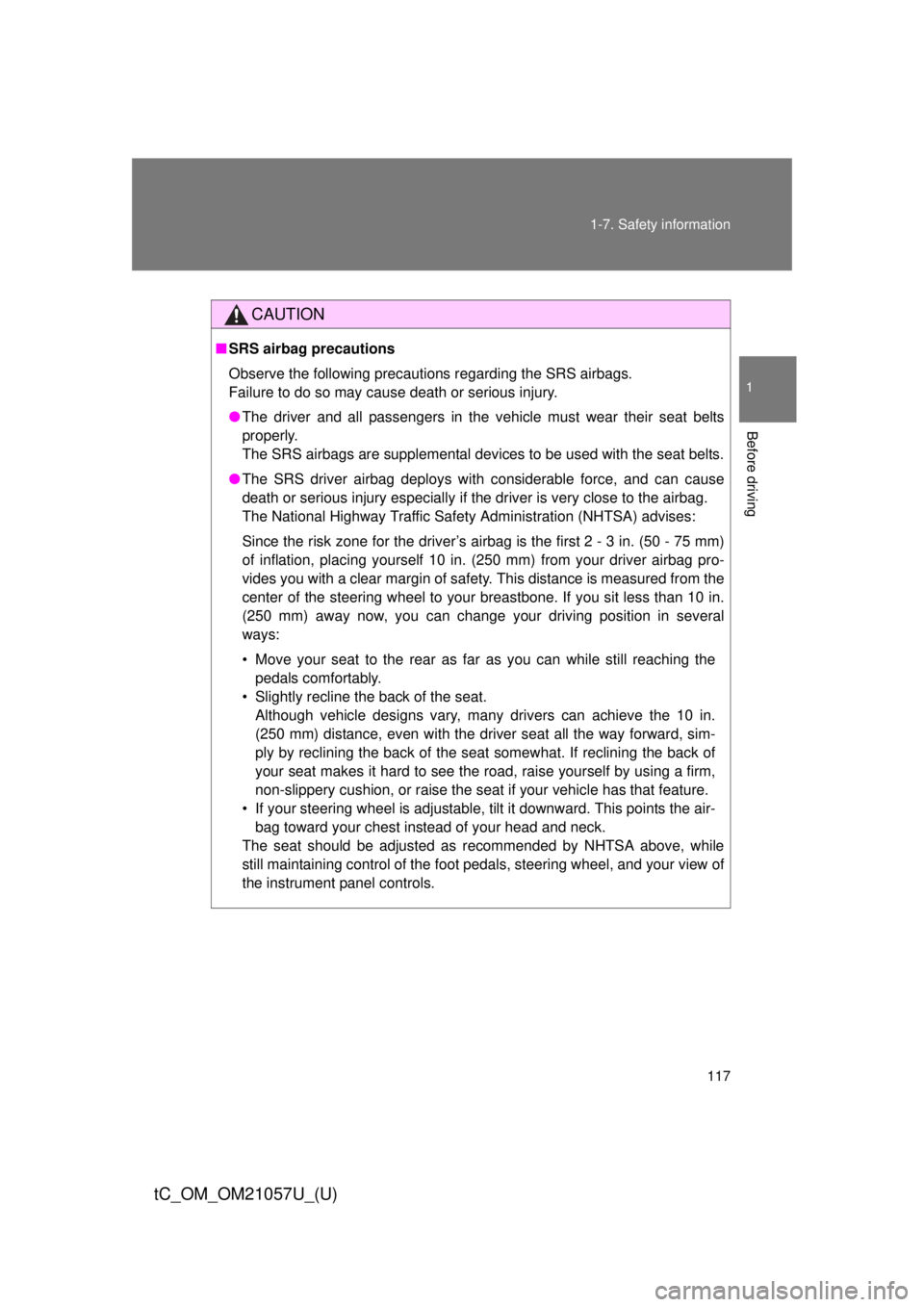
117
1-7. Safety information
1
Before driving
tC_OM_OM21057U_(U)
CAUTION
■
SRS airbag precautions
Observe the following precautions regarding the SRS airbags.
Failure to do so may cause death or serious injury.
●The driver and all passengers in the vehicle must wear their seat belts
properly.
The SRS airbags are supplemental devices to be used with the seat belts.
● The SRS driver airbag deploys with considerable force, and can cause
death or serious injury especially if the driver is very close to the airbag.
The National Highway Traffic Safety Administration (NHTSA) advises:
Since the risk zone for the driver’s airbag is the first 2 - 3 in. (50 - 75 mm)
of inflation, placing yourself 10 in. (250 mm) from your driver airbag pro-
vides you with a clear margin of safety. This distance is measured from the
center of the steering wheel to your breastbone. If you sit less than 10 in.
(250 mm) away now, you can change your driving position in several
ways:
• Move your seat to the rear as far as you can while still reaching the pedals comfortably.
• Slightly recline the back of the seat. Although vehicle designs vary, many drivers can achieve the 10 in.
(250 mm) distance, even with the driver seat all the way forward, sim-
ply by reclining the back of the seat somewhat. If reclining the back of
your seat makes it hard to see the road, raise yourself by using a firm,
non-slippery cushion, or raise the seat if your vehicle has that feature\
.
• If your steering wheel is adjustable, tilt it downward. This points the air- bag toward your chest instead of your head and neck.
The seat should be adjusted as recommended by NHTSA above, while
still maintaining control of the foot pedals, steering wheel, and your view of
the instrument panel controls.
Page 123 of 492
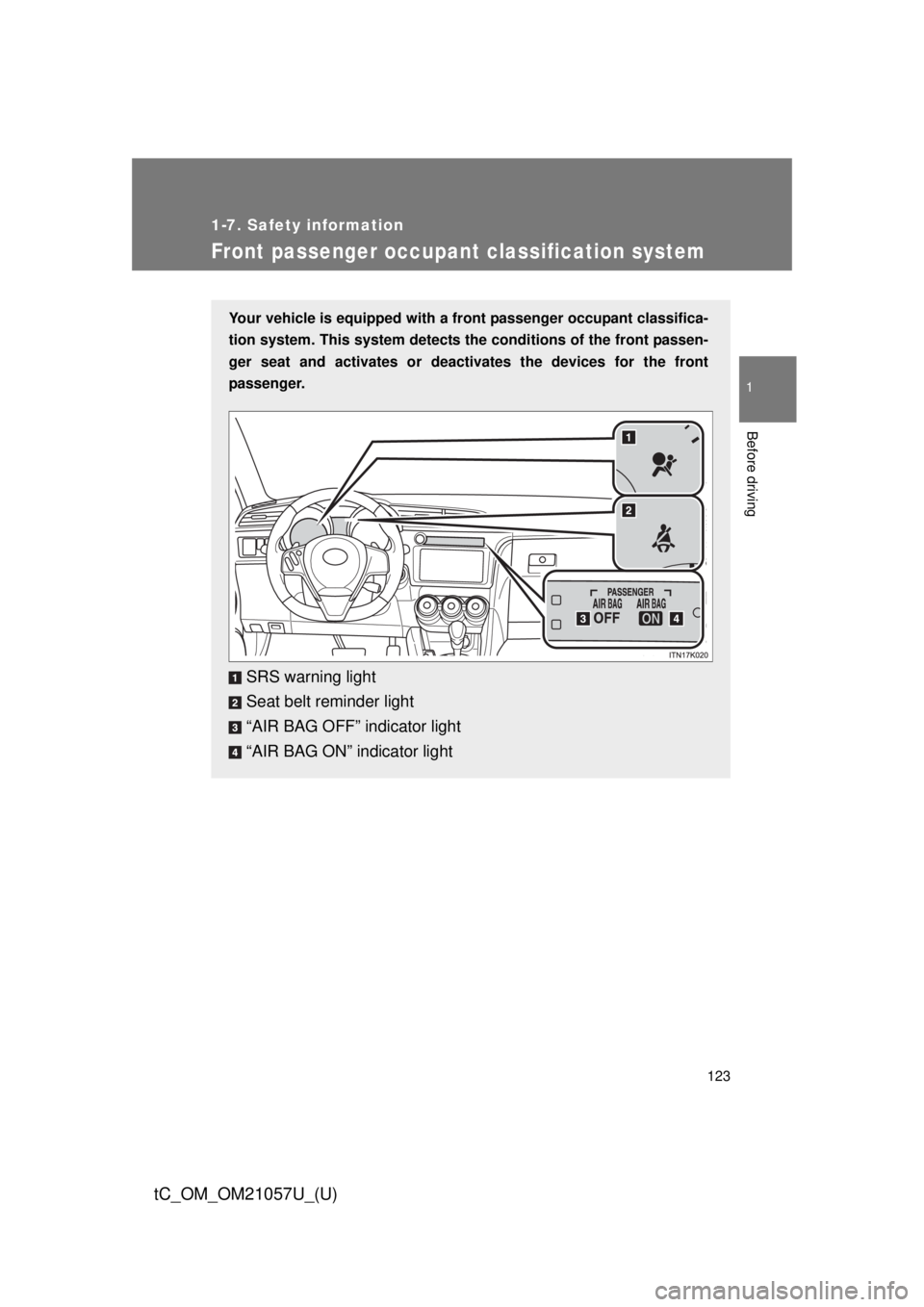
123
1
1-7. Safety information
Before driving
tC_OM_OM21057U_(U)
Front passenger occupant classification system
Your vehicle is equipped with a front passenger occupant classifica-
tion system. This system detects the conditions of the front passen-
ger seat and activates or deactiv ates the devices for the front
passenger.
SRS warning light
Seat belt reminder light
“AIR BAG OFF” indicator light
“AIR BAG ON” indicator light
Page 124 of 492

124 1-7. Safety information
tC_OM_OM21057U_(U)
Conditions and operation of the front passenger occupant clas-
sification system■ Adult
*1
■Child*4 or child restraint system*5
Indicator/
warning light “AIR BAG ON” and
“AIR BAG OFF” indicator lights
“AIR BAG ON”
SRS warning light Off
Seat belt reminder light Off
*2 or
flashing
*3
Devices Front passenger airbag
Activated
Side airbag on the front
passenger seat
Curtain shield airbag in the front passenger side
Front passenger knee airbag
Front passenger’s seat belt pretensioner
Indicator/
warning light “AIR BAG ON” and
“AIR BAG OFF” indicator lights
“AIR BAG OFF”
*6
SRS warning light Off
Seat belt reminder light Off
*2 or
flashing
*3
Devices Front passenger airbag Deactivated
Side airbag on the front passenger seat Activated
Curtain shield airbag in the front
passenger side
Front passenger knee airbag Deactivated
Front passenger’s seat belt pretensioner Activated
Page 125 of 492

125
1-7. Safety information
1
Before driving
tC_OM_OM21057U_(U)
■
Unoccupied
■ There is a malfunction in the system
Indicator/
warning light “AIR BAG ON” and
“AIR BAG OFF” indicator lights Not
illuminated
SRS warning light Off
Seat belt reminder light
Devices Front passenger airbag
Deactivated
Side airbag on the front passenger seat Activated
Curtain shield airbag in the front
passenger side
Front passenger knee airbag Deactivated
Front passenger’s seat belt pretensioner Activated
*7
or
deactivated
*8
Indicator/
warning light “AIR BAG ON” and
“AIR BAG OFF” indicator lights
“AIR BAG OFF”
SRS warning light On
Seat belt reminder light Flashing
Devices Front passenger airbag
Deactivated
Side airbag on the front passenger seat Activated
Curtain shield airbag in the front
passenger side
Front passenger knee airbag Deactivated
Front passenger’s seat belt pretensioner Activated
Page 126 of 492

126 1-7. Safety information
tC_OM_OM21057U_(U)
*1: The system judges a person of adult size as an adult. When asmaller adult sits in the front passenger seat, the system may rec-
ognize him/her as a child depending on his/her physique and pos-
ture.
*2: In the event the front passen ger is wearing a seat belt.
*3: In the event the front passenger does not wear a seat belt.
*4: When a larger child who has outgrown a child restraint system
sits in the front passenger seat, the system may recognize him/
her as an adult depending on hi s/her physique or posture.
*5: Never install a rear-facing child restraint system on the front pas-
senger seat. A forward-facing ch ild restraint system should only
be installed on the front passenger seat when it is unavoidable.
( P. 129)
*6: In case the indicator light is not illuminated, consult this manual
on how to install the child restraint system properly. ( P. 135)
*7: In the event of a side collision.
*8: In the event of a frontal collision.